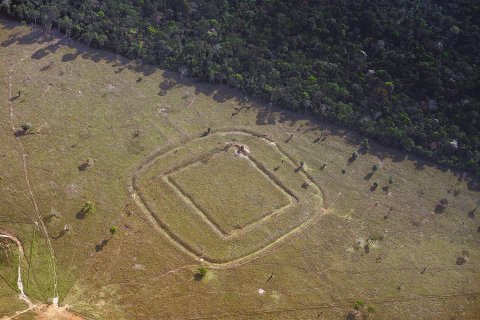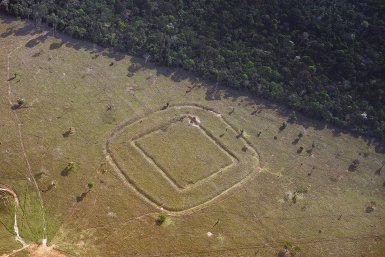Amazon May Conceal Over 10,000 Hidden Earthworks Constructed by Pre-Columbian Societies
The Amazon rainforest may be home to thousands of hidden earthworks, made by pre-Columbian societies. This is revealed by a large international study investigating the distribution of these hidden structures. Biologist Hans ter Steege contributed to the research. “This discovery tells us that certain parts of the forest may not be as old as we initially thought.”

The dense Amazon Rainforest may hold far more traces of human civilization than previously believed. A new study, combining scan data with archaeological information and statistical methods, suggests that over 10,000 hidden pre-Columbian remnants could be found. These remnants mainly consist of earthworks, structures made from raised or excavated earth.
The research, published today in Science, was led by Brazilian scientists Vinicius Peripato, Carolina Levis, and Luiz Aragão. Hans ter Steege, biologist at Utrecht University and Naturalis Biodiversity Center, also collaborated on the study. According to Ter Steege, geoglyphs can tell us a lot about the history of the Amazon. The research implies, for example, that the Amazon rainforest might not be as untouched as many think.
Scanning through the Canopy
The research team studied the forest floor from aircraft. To peer through the thick canopy, they used laser scanners capable of creating highly detailed 3D scans of the ground surface. The scanning technology, called LiDAR, filters out vegetation from the image, revealing hills and trenches indicating remnants of past societies.

In previous studies, around 900 scanner flights were conducted. This research adds 36 more, uncovering 24 new geoglyphs. Based on all the geoglyphs found so far, the researchers predict that many more of these structures remain undiscovered. Considering variables such as temperature, precipitation, soil type, and distance to water bodies, the researchers estimate that the Amazon rainforest may even hold more than 16,187 undiscovered earthwork sites .
History of the Amazon
The findings have significantly shifted our understanding of the Amazon rainforest. Until now, many scientists assumed that the forest remained untouched for centuries, but the earthworks suggest human habitation in the forest even before Europeans arrived. Some anthropologists even argue that most of the Amazon was once inhabited.
Earthworks and Domesticated Trees
Ter Steege adds nuance to the idea that the entire Amazon was once inhabited. According to Ter Steege, it’s highly unlikely that humans had a significant impact in 80 percent of the forest. He makes this claim based on the distribution of the discovered earthworks and the spread of domesticated trees.
In some areas, these trees are so abundant that they must have been planted by people.
Ter Steege: “There is an overlap between the places where the earthworks are found and where domesticated species are present.” These species include trees like the Brazil nut, forest grape, and cacao trees, which are useful for human societies. In some areas, these trees are so abundant that they must have been planted by people. However, a significant portion of the Amazon seems to have been largely untouched.
Land Rights
Research on earthworks is not only relevant from a scientific perspective but could also has societal implications. Indigenous inhabitants of the Amazon may use this research to show the Brazilian government that they have been living in the forest for decades, thereby maintaining their land rights.
The discovery of geoglyphs tells us that certain parts of the forest may not be as old as we initially thought
Additionally, earthwork research is crucial for the Amazon Tree Diversity Network, coordinated by Ter Steege. This research group maps the vegetation of the Amazon rainforest. “The discovery of geoglyphs tells us that certain parts of the forest may not be as old as we initially thought”, says Ter Steege. “Humans and nature have been living together there for centuries.”

